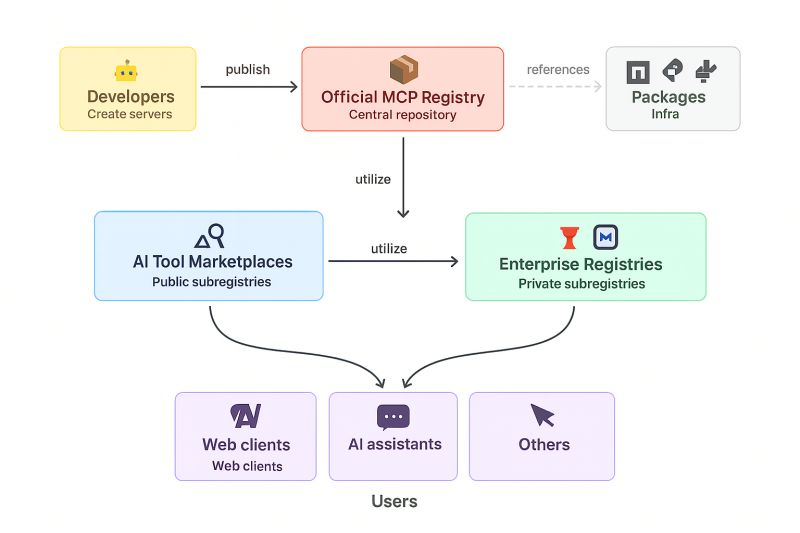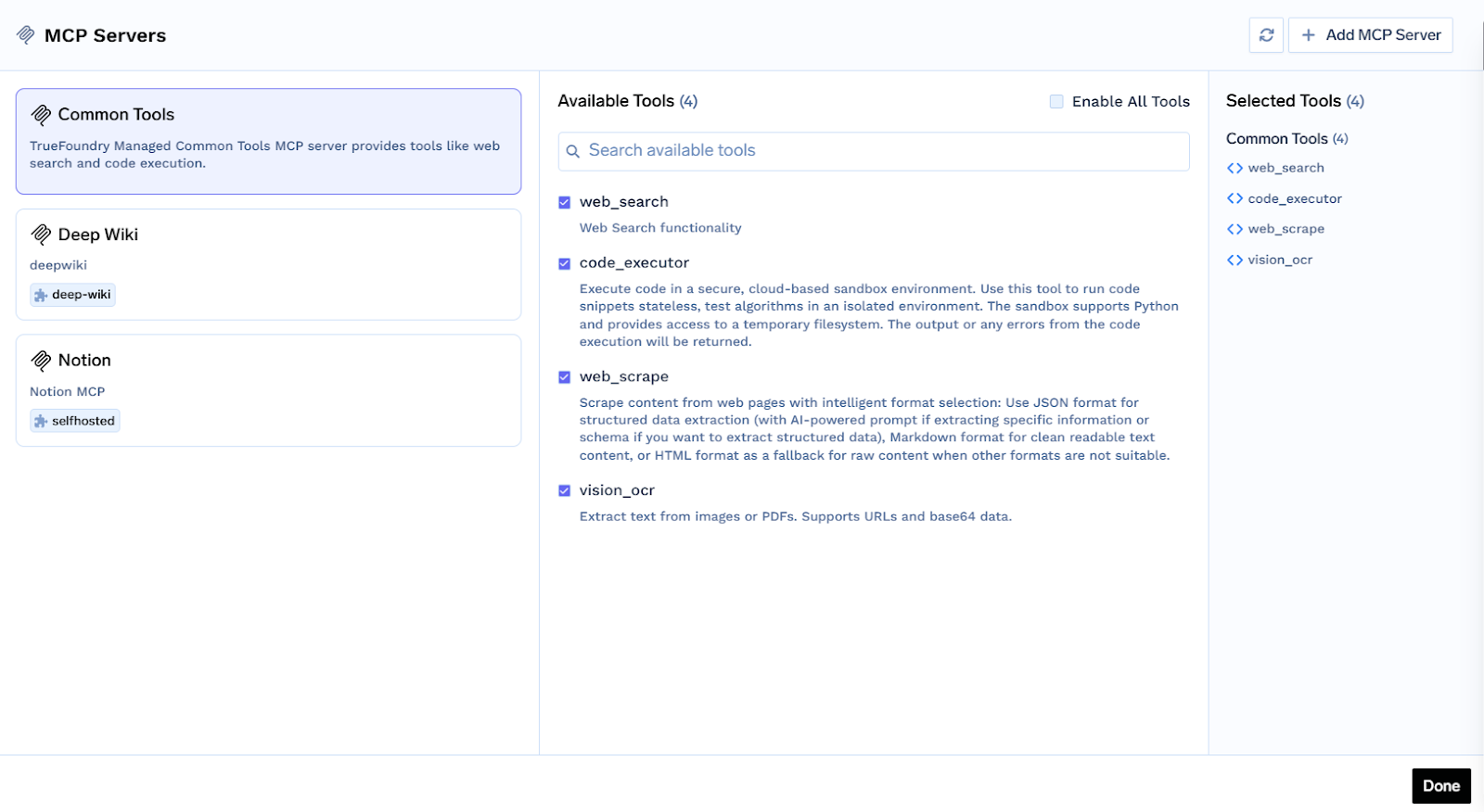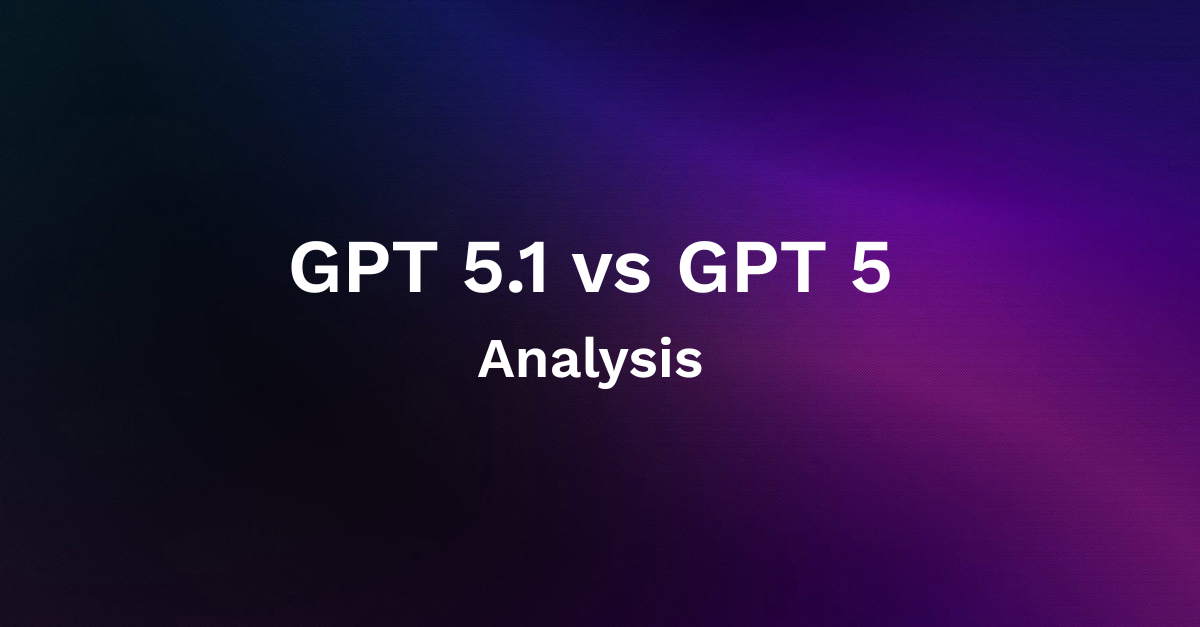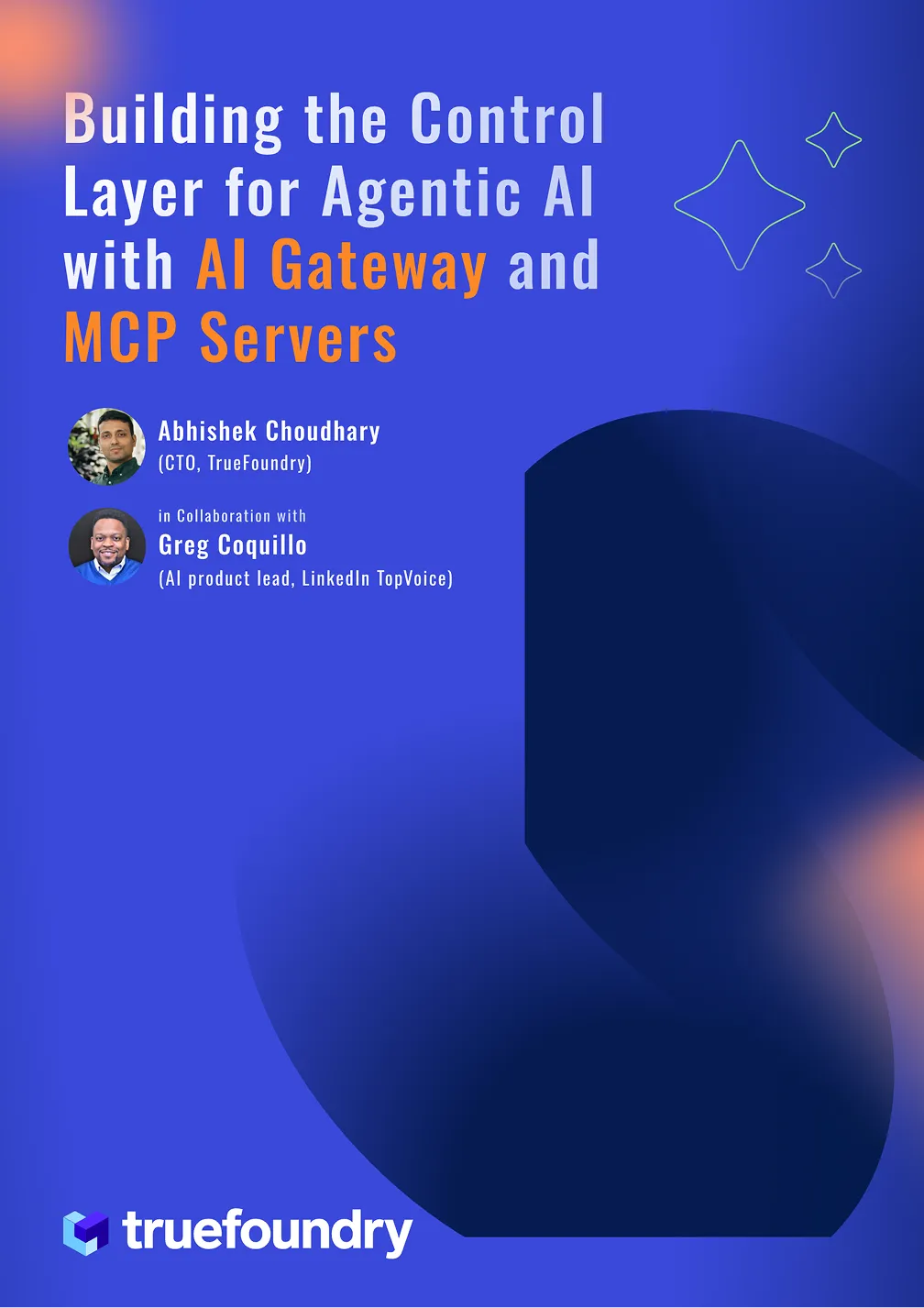What is MCP Registry?
In February 2025, the MCP Registry emerged as a centralized platform for the Model Context Protocol (MCP) ecosystem, aiming to standardize how MCP servers are discovered, registered, and accessed.
Until its launch, MCP adopters had to navigate fragmented server lists, private implementations, and community-driven catalogs, making tool integration and interoperability challenging.
The MCP Registry addresses these issues by acting as a single source of truth for publicly available MCP servers, while enabling the creation of public or private sub-registries tailored to specific client needs. By providing structured metadata, API schemas, and community moderation mechanisms, it allows developers and organizations to reliably discover and interact with MCP servers.
This foundation not only improves accessibility and governance but also accelerates the adoption of context-aware AI applications across the ecosystem.
What is MCP Registry?
The MCP Registry is a centralized, open catalog and API for the Model Context Protocol (MCP) ecosystem. It standardizes how MCP servers are discovered, registered, and accessed. MCP itself defines a protocol for structured communication between large language models (LLMs) and external tools or systems, enabling models to perform real-world actions reliably. The registry acts as the backbone of this ecosystem, providing a single source of truth where MCP server maintainers can publish metadata, API schemas, and other essential information about their services.
Unlike fragmented or ad-hoc server lists, the MCP Registry ensures that clients can discover and integrate with servers consistently. It supports both public sub-registries, such as marketplaces curated for specific MCP clients, and private sub-registries within enterprises that require strict privacy or security.
In either case, the registry provides standardized APIs and schemas that allow downstream consumers to interact with MCP servers predictably.
Key features of the MCP Registry include:
- Centralized discovery: A single source of truth for all publicly available MCP servers.
- Standardized metadata: Structured definitions of server capabilities and input-output schemas.
- Public and private sub-registries: Flexible options for enterprises and client-specific marketplaces.
- Community moderation: Mechanisms to flag or remove spam, malicious, or non-compliant servers.
The MCP Registry is more than a listing. It is foundational infrastructure that facilitates discoverability, governance, and interoperability across the MCP ecosystem, enabling LLMs to interact with external tools in a structured and scalable manner.
How the MCP Registry Works
The MCP Registry is a centralized platform for Model Context Protocol (MCP) servers, enabling large language models (LLMs) to discover and interact with external tools and services reliably.
Server Registration
MCP server maintainers submit their servers to the registry by providing structured metadata, including:
- API Endpoints: URLs for accessing the server's functionalities
- Authentication Methods: Details on how clients can securely connect
- Input/Output Specifications: Definitions of the data formats and structures that the server accepts and returns
- Capabilities and Metadata: Information about the server's functionalities and relevant tags or categories
This structured approach ensures that clients can programmatically discover and understand the capabilities of each server.
Discovery and Interaction
Once registered, MCP clients can query the registry to locate servers that meet specific criteria. The registry provides search functionality and standardized server descriptions, allowing clients to interpret the server’s capabilities and data structures consistently. This ensures that models can reliably identify which servers to use for particular tasks.
Integration with Clients
After discovery, MCP clients generate structured requests according to the server’s input specifications, handle authentication securely, and process responses in the expected format. This enables LLMs to execute real-world actions such as querying databases, invoking APIs, or interfacing with external systems in a predictable and standardized manner.
Community Moderation
To maintain quality and security, the registry includes a community-driven moderation mechanism. Users can flag servers that contain spam or malicious code, and maintainers review these reports to denylist problematic entries. This ensures that the registry remains a reliable resource for developers and organizations.
Core Functions of an MCP Registry
The MCP Registry serves as the backbone of the Model Context Protocol ecosystem by providing essential functionalities that enable LLMs to interact reliably with external tools and services. Its core functions ensure discoverability, standardization, and governance, addressing challenges faced by developers when integrating multiple MCP servers.
Server Discovery: One of the primary functions of the MCP Registry is to allow clients to locate servers efficiently. By maintaining structured metadata, including capabilities, tags, and input-output schemas, the registry enables LLMs to filter and select the most appropriate servers for a given task. This reduces trial-and-error integration and ensures that models can rely on accurate, compatible endpoints.
Standardization and Metadata Management: The registry enforces a uniform format for server descriptions, input-output definitions, authentication methods, and versioning.
Standardized metadata ensures interoperability across clients and servers, enabling LLMs to understand and invoke servers without custom adaptations or hardcoded logic.
Integration Facilitation: Beyond discovery, the MCP Registry provides APIs and schemas that streamline integration. Clients can generate structured requests, securely handle authentication, and process server responses in predictable formats.
This allows LLMs to execute real-world actions such as API calls or database queries safely and reliably.
Governance and Moderation: To maintain trust and reliability, the registry incorporates community-driven moderation. Users can flag malicious or non-compliant servers, and maintainers review and denylist problematic entries. This protects clients from unverified or unsafe servers.
By combining these functions, the MCP Registry ensures that LLMs and external tools can interact in a structured, scalable, and secure manner, forming the foundation for robust, context-aware AI applications.
Architecture of an MCP Registry

The Model Context Protocol (MCP) Registry is a centralized, open-source system designed to facilitate the discovery, integration, and management of MCP servers.
It provides a standardized repository where developers and organizations can register and access MCP-compatible services, ensuring seamless interoperability between large language models (LLMs) and external tools.
At the heart of the registry is a centralized metadata store that maintains detailed records of registered MCP servers. This metadata includes capabilities, input-output schemas, authentication mechanisms, and versioning information, allowing clients to programmatically discover and interact with servers that meet their specific requirements.
Communication within the MCP Registry is built on the JSON-RPC 2.0 protocol, a lightweight and stateless framework that enables efficient remote procedure calls over HTTP. This ensures that clients can invoke server functionalities using well-defined inputs and receive structured responses in a standardized format.
Security is a key focus, with robust authentication mechanisms such as OAuth 2.0 to restrict access to authorized clients, protecting sensitive data and operations.
Additionally, the MCP Registry incorporates a community-driven moderation and governance system. Users can report servers that are malicious, non-compliant, or of low quality, and registry maintainers review these reports to denylist problematic entries. This approach ensures that the registry remains reliable, trustworthy, and aligned with MCP standards, providing a solid foundation for building context-aware AI applications.
Benefits of Using an MCP Registry
The MCP Registry offers multiple advantages that make it a cornerstone of the Model Context Protocol ecosystem. One of the primary benefits is centralized discoverability. By providing a single source of truth for MCP servers, the registry allows clients to locate services quickly and reliably. This eliminates the need for fragmented, ad-hoc server lists and reduces errors in integration, ensuring that LLMs can access the right tools for specific tasks.
Key benefits include:
- Quick server discovery: Clients can find compatible MCP servers efficiently.
- Standardized APIs: Uniform input-output specifications and authentication protocols simplify integration.
- Improved security: Authentication and moderation mechanisms ensure trusted interactions.
- Scalability: Public and private sub-registries allow organizations to manage large deployments.
- Governance and compliance: Centralized metadata enables version control, auditing, and accountability.
The registry also enhances security and governance. With community-driven moderation, users can flag non-compliant or malicious servers, and maintainers can denylist them, preserving the integrity and reliability of the ecosystem.
By supporting standardization, the MCP Registry enables predictable client-server interactions, reduces integration complexity, and ensures interoperability across tools and platforms.
Its scalable architecture allows enterprises to deploy context-aware AI workflows efficiently while maintaining consistency and compliance.
Overall, the MCP Registry empowers developers and organizations to build robust, reliable, and secure AI applications. By centralizing discovery, enforcing standardization, enhancing security, and supporting scalable deployment, it provides a foundation for efficient, trustworthy, and future-ready AI ecosystems.
TrueFoundry MCP Registry (with Registry)
The TrueFoundry MCP Registry centralizes how AI agents discover, authenticate, and interact with Model Context Protocol (MCP) servers across an organization.
MCP is an open standard that connects LLMs to external tools and data sources like Slack, GitHub, or internal APIs. It acts as a “USB-C for AI,” offering a universal interface for tool integration.
Instead of every developer managing their own MCP servers and credentials, the registry serves as a single source of truth. It maintains metadata, authentication settings, and access policies for all registered servers.
Integrated with the TrueFoundry AI Gateway, it provides centralized authentication, access control, and secure orchestration of agent workflows.
Administrators can organize MCP servers into groups (for example, dev-mcps or prod-mcps) and define fine-grained access permissions. Supported authentication methods include OAuth2, header-based, and token-based mechanisms.
Users can generate a single Personal Access Token (PAT) or Virtual Account Token (VAT) to securely access all authorized MCP servers. This unified architecture enables dynamic tool discovery, secure automation, and scalable agentic AI workflows across the enterprise.
How to Add MCP Servers to the TrueFoundry MCP Registry
The TrueFoundry MCP Registry provides a centralized way to register, manage, and govern access to all your MCP servers. You can add both public and self-hosted MCP servers to the registry through the TrueFoundry AI Gateway UI or API.
Step 1: Create an MCP Server Group
Before adding a server, create an MCP Server Group to organize servers by environment or team. For example:
To create a new group:

- Navigate to the AI Gateway - MCP Servers section.
- Click Add New MCP Server Group.
- Enter a Group Name and optional description.
- Configure Access Control:
- Click Save to create the group.
Step 2: Add an MCP Server

Once the group is created:
- Open the group and click Add/Edit MCP Server.
- Provide the following details:
- Name: A descriptive name (e.g., Slack MCP Server).
- Description: A short explanation of the server’s purpose.
- Endpoint URL: The base URL where the MCP server is hosted.
- Auth Type: Select one of the supported mechanisms:
No Auth
Header-Based Auth (for static tokens)
OAuth2 (for dynamic, secure authentication)
- Save the configuration to register the server.
Step 3: Verify and Test in the Playground
After registration, the server appears in the MCP Playground. You can:

- Test tools exposed by the MCP server.
- Observe live request and response streams between the LLM and the server.
- Generate ready-to-use code snippets for integration into your applications.
This setup ensures centralized governance, consistent authentication, and quick onboarding of new tools into your AI ecosystem.
MCP Registry vs. Other Registries
The MCP Registry stands out from traditional registries due to its focus on standardizing interactions between large language models (LLMs) and external tools. Unlike container registries or general API catalogs that primarily store artifacts or endpoints, the MCP Registry maintains structured metadata about server capabilities, input-output schemas, authentication mechanisms, and versioning.
This enables LLMs to discover and interact with servers predictably, ensuring reliable execution of real-world tasks.
Traditional registries, such as general API registries or package repositories, often lack standardized definitions for model-tool interactions. They may list endpoints or packages, but do not enforce uniform schemas or provide a single source of truth for client applications.
In contrast, the MCP Registry centralizes this information, supporting both public and private sub-registries while allowing governance, access control, and community moderation.
By providing standardized schemas, centralized discovery, access control, and governance, the MCP Registry enables developers and organizations to integrate LLMs with external systems reliably. This structured approach reduces integration errors, improves security, and supports scalable AI workflow capabilities that conventional registries typically cannot offer.
Challenges in Managing an MCP Registry
While the MCP Registry provides centralized discovery and standardized integration for LLMs, managing it comes with several challenges. One of the primary issues is keeping metadata accurate and up to date. MCP servers frequently update capabilities, input-output specifications, and authentication methods. Without automated validation and synchronization, outdated metadata can lead to failed integrations or runtime errors for clients.
Security and access control are also critical challenges. With multiple users, teams, and organizations accessing the registry, it is essential to enforce granular permissions and monitor usage. Misconfigured access or compromised tokens can expose sensitive systems or data to unauthorized parties.
Another challenge lies in scalability and performance. As the number of registered MCP servers grows, the registry must handle increased query loads from clients while maintaining low latency. Efficient indexing, caching, and search algorithms become crucial to ensure responsive and reliable service discovery.
Finally, community moderation and governance require ongoing attention. Ensuring that servers comply with standards, are free from malicious code, and maintain quality requires active review and reporting mechanisms. Balancing automation with human oversight is essential to maintain trust and reliability across the ecosystem.
Despite these challenges, a well-managed MCP Registry remains a cornerstone for enabling structured, secure, and scalable AI workflows.
Conclusion
The MCP Registry plays a pivotal role in the Model Context Protocol ecosystem by providing a centralized, standardized, and secure platform for discovering and managing MCP servers. Maintaining structured metadata, supporting access control, and enabling both public and private sub-registries, it allows large language models to interact with external tools reliably and predictably.
While challenges such as metadata accuracy, security, scalability, and governance exist, the registry’s structured approach, combined with community-driven moderation, ensures that these can be effectively managed. Ultimately, the MCP Registry empowers developers and organizations to build robust, context-aware AI applications, streamlining integrations, reducing errors, and fostering trust across the AI ecosystem. It forms a critical foundation for scalable, reliable, and future-ready AI workflows.
Built for Speed: ~10ms Latency, Even Under Load
Blazingly fast way to build, track and deploy your models!
- Handles 350+ RPS on just 1 vCPU — no tuning needed
- Production-ready with full enterprise support
TrueFoundry AI Gateway delivers ~3–4 ms latency, handles 350+ RPS on 1 vCPU, scales horizontally with ease, and is production-ready, while LiteLLM suffers from high latency, struggles beyond moderate RPS, lacks built-in scaling, and is best for light or prototype workloads.


















